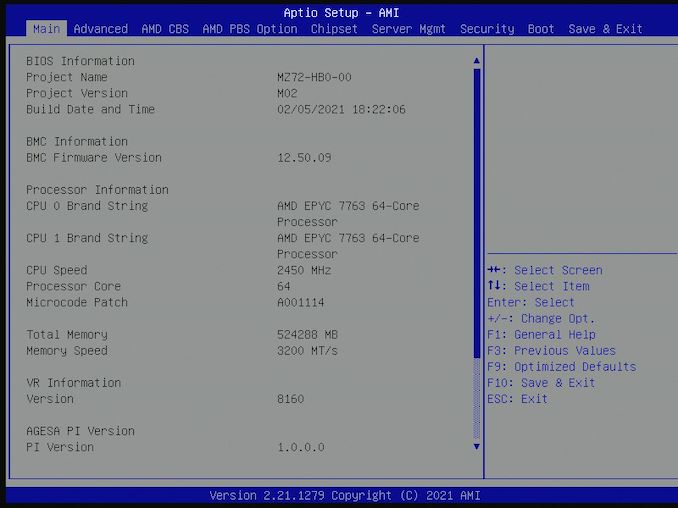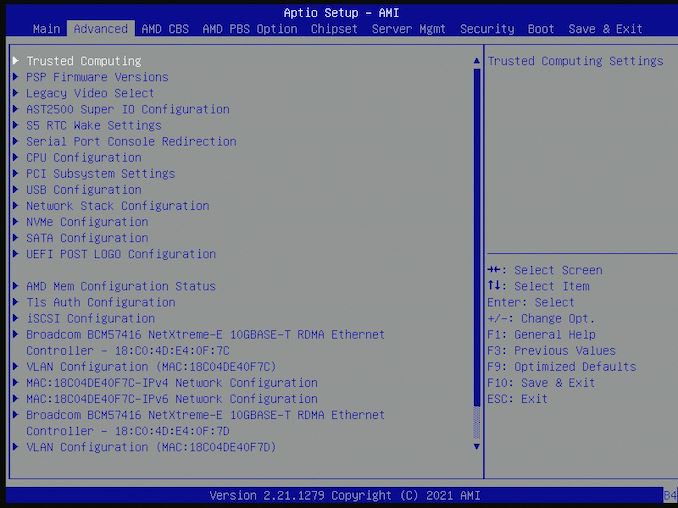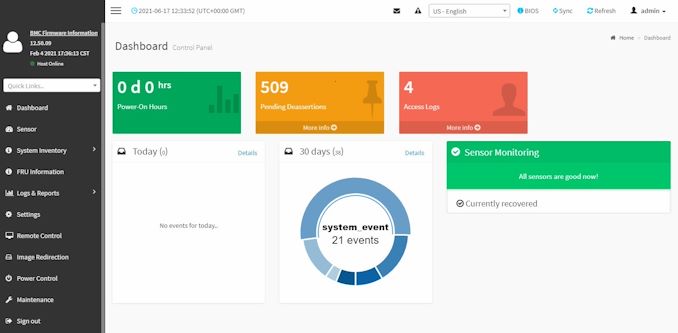The GIGABYTE MZ72-HB0 (Rev 3.0) Motherboard Review: Dual Socket 3rd Gen EPYC
by Gavin Bonshor on August 2, 2021 9:30 AM EST- Posted in
- Motherboards
- AMD
- Gigabyte
- GIGABYTE Server
- Milan
- EPYC 7003
- MZ720-HB0
BIOS
When it comes to the firmware on the GIGABYTE MZ72-HB0, it's nothing fancy, flashy, or glossed over for consumers to eyeball. It is using a basic and archaic-looking Aptio AMI firmware version, which focuses on functionality and substance over style. The GUI is basic, with a deep blue edging and scroll bar, with the help menu text in the bottom right-hand corner also in the same blue. The text is a well-contrasted black with a light grey background, which makes everything easy to read.
Entering the firmware, the main screen has a basic list of information that includes the firmware version that is currently being used, as well as basic information on the processors installed; in this case, two AMD EPYC 7763 64-core and 128-thread Zen 3 processors. It includes the base clock speed, as well as the core count, and also includes a combined total of installed memory with its speed in MT/s (it's great to see some vendors using the correct definition of Megatransfers per second).
The BIOS itself has very deep and contrived menus and options for users to delve into. Along the top, there's the Advanced section with options for Trusted Computing, ASPEED BMC configuration, CPU, USB, PCI, and storage configuration. Users can also alter and customize the MAC address settings for gaining access to the system across a network using the Gigabit Management Ethernet port on the rear panel.
Other menus include the AMD CBS and PBS options for power limitations, and altering Precision Boost Overdrive settings, while the Chipset menu includes options for enabling or disabling the PCIe compliance mode. There's also a dedicated menu for Server Management, where users can also configure the BMC networking settings, as well as view FRU information. The Security menu allows users to enable a firmware level administration and user password, especially if they want to keep non-essential users out of core settings, while the Boot menu allows users to customize the boot and POST order of any installed storage devices.
Overall the firmware on the MZ72-HB0 is functional, and with options aplenty, there's a lot of substance for users of multiple disciplines, including cloud, server, and workstation users.
Software/BMC
Although the GIGABYTE MZ72-HB0 doesn't come with a software bundle per se, it does include access to its MegaRAC SP-X browser-based interface. It includes both a JAVA and neat HTML5 based user interface, and GIGABYTE adopts a more modern look than previous years of its server-focused models.
The GIGABYTE MegaRAC SP-X interface includes all the typical options of a board of this caliber should, including system inventory which shows the user's installed CPU, memory, storage, PCIe, and NIC inventories. Users can also look at the detailed information of the components in each of the subsections, as well as associated and supported technologies that can be used with the installed processor including hyperthreading, Execute Disable (XD), and if turbo mode is functioning or not. The MegaRAX SP-X interface also allows users to use BMC functionality, as well as powering up or down a system, as well as capturing BSOD, which is particularly handy if something isn't running as stable as it should.
There's also a load of security, power-related, and logging options available for users to sink their teeth into. As a board of this pedigree and for its functionality in server, workstation, and more intensive use cases such as cloud servers, it looks to be fully equipped from an access interface point of view. Users can even flash the board to the latest version of the firmware over the interface and BMC, as well as save and load up pre-saved configurations for deploying the same settings across multiple servers/systems.
Overall the GIGABYTE MegaRAC SP-X is functional, easy to navigate, has a plethora of options for users to monitor and alter, and it's very good to look at too.

























28 Comments
View All Comments
tygrus - Monday, August 2, 2021 - link
There are not many apps/tasks that make good use of more than the 64c/128t. Some of those tasks are better suited for GPU, accelerators or a cluster of networked systems. Some tasks just love having the TB's RAM while others will be limited by data IO (storage drives, network). YMMV. Have fun with testing it but it will be interesting to find people with real use cases that can afford this.questionlp - Monday, August 2, 2021 - link
Being capable of handling more than 64c/128t across two sockets doesn't mean that everyone will drop more than that on this board. You can install two higher clock 32c/64t processors into each socket, have shed load of RAM and I/O for in-memory databases, software-defined (insert service here) or virtualization (or a combination of those).Installer lower core count, even higher clock speed CPUs and you have yourself an immensely capable platform for per-core licensed enterprise database solutions.
niva - Wednesday, August 4, 2021 - link
You can but why would you when you can get a system where you can slot a single CPU with 64C?This is a board for the cases where 64C is clearly not enough, and really catering towards server use, for cases where less cores but more power per core are needed, there are simply better options.
questionlp - Wednesday, August 4, 2021 - link
The fastest 64c/128t Epyc CPU right now as a base clock of 2.45 GHz (7763) while you can get 2.8 GHz with a 32c/128t 7543. Slap two of those on this board, you'll get a lot more CPU power than a single 64c/128t and double the number of memory channels.Another consideration is licensing. IIRC, VMware per-CPU licensing maxes out at 32c per socket. To cover a single 64c Epyc, you would end up with the same license count as two 32c Epyc configuration. Some customers were grandfathered in back in 2020; but, that's no longer the case for new licenses. Again, you can scale better with 2 CPU configuration than 1 CPU.
It all depends on the targeted workload. What may work for enterprise virtualization won't work for VPC providers, etc.
linuxgeex - Monday, August 2, 2021 - link
The primary use case is in-memory databases and/or high-volume low-latency transaction services. The secondary use case is rack unit aggregation, which is usually accomplished with virtualisation. ie you can fit 3x as many 80-thread high performance VPS into this as you can into any comparably priced Intel 2U rack slot, so this has huge value in a datacenter for anyone selling such a VPS in volume.logoffon - Monday, August 2, 2021 - link
Was there a revision 2.0 of this board?Googer - Tuesday, August 3, 2021 - link
There is a revision 3.0 of this board.MirrorMax - Friday, August 27, 2021 - link
No and more importantly this is exactly the same board as rev1 but with a Rome/Milan bios, so you can bios update rev1 boards to rev3 basically, odd that the review doesn't touch on thisBikeDude - Monday, August 2, 2021 - link
Task Manager screenshot reminded me of Norton Speed Disk; We now have more CPUs than we had disk clusters back in the day. :PWaltC - Monday, August 2, 2021 - link
In one place you say it took 2.5 minutes to post, in another place you say it took 2.5 minutes to cold boot into Win10 pro. I noticed you used a Sata 3 connector for your boot drive, apparently, and I was reminded of booting Win7 from a Sata3 7200rpm platter drive taking me 90-120 seconds to cold boot--in Win7 the more crowded your system with 3rd-party apps and games the longer it took to boot...;) (That's not the case with Win10/11, I'm glad to say, as with TB's of installed programs I still cold boot in ~12 secs from an NVMe OS partition.) Basically, servers are not expected to do much in the way of cold booting as up time is what most customers are interested in...but I doubt the S3 drive had much to do with the 2.5 minute cold-boot time, though. An NVMe drive might have shaved a few seconds off the cold-boot, but that's about it, imo.Interesting read! Enjoyed it. Yes, the server market is far and away different from the consumer markets.